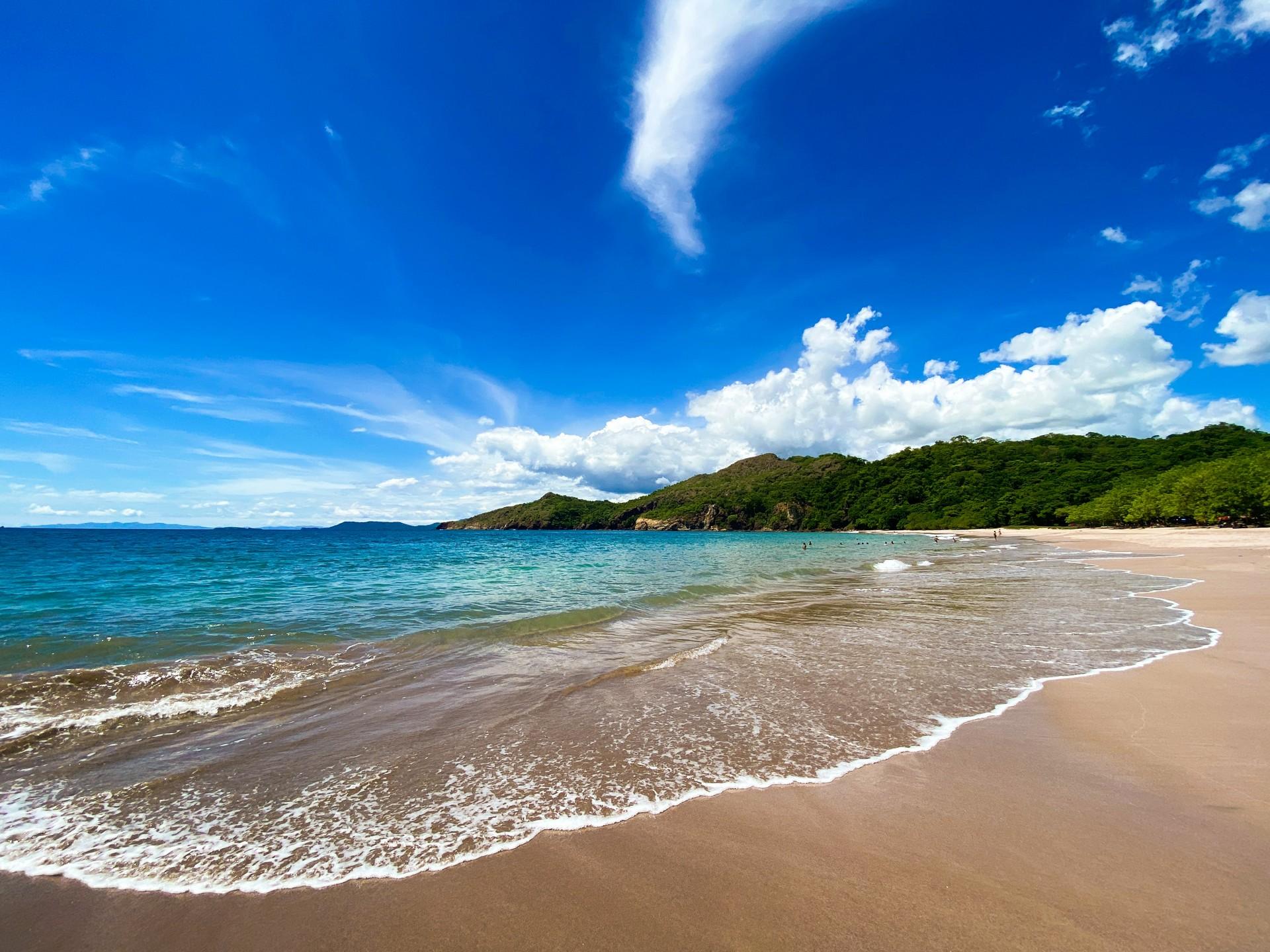Small, diverse, green, full of tropical life. At every turn – whether in the magnificent mountain landscape of three thousand feet, on the coast or trekking through the misty rainforest. In the context of Central America, Costa Rica is a bit of an otherworldly revelation. Among countries with turbulent histories, wracked by civil wars and poverty, oppressed by treacherous dictators, Costa Rica appears to be an island of democracy, freedom and more or less equal opportunities for all.
And how is it in reality, in this beautiful and lovely country?
Switzerland of Central America
Proudly nicknamed the "Switzerland of Central America", which probably stems from its neutrality during the Cold War and its production of fine medical devices. Lately, however, this Mesoamerican paradise has been beset by economic problems and rising crime, so the Swiss dream is somewhat unravelling. Even so, on the banana and coffee plantations that drive the economy, you are more likely to find workers from Panama, Nicaragua or Honduras than Ticos, as the Costa Ricans are called.
However, the country's real name means something like 'rich coast', which was more wishful thinking of the early conquistadors than reality. One version puts it down to Christopher Columbus himself, who landed here in 1502 and was bewitched by the gold jewellery of the local Indians. Unfortunately for them, no precious metals were found here and the so-called Rich Coast was one of the poorest colonies of New Spain. Only the hardest-working immigrants survived here, coming to farm in swarms of mosquitoes and Indian arrows from as far away as Galicia and other poorer parts of Spain.
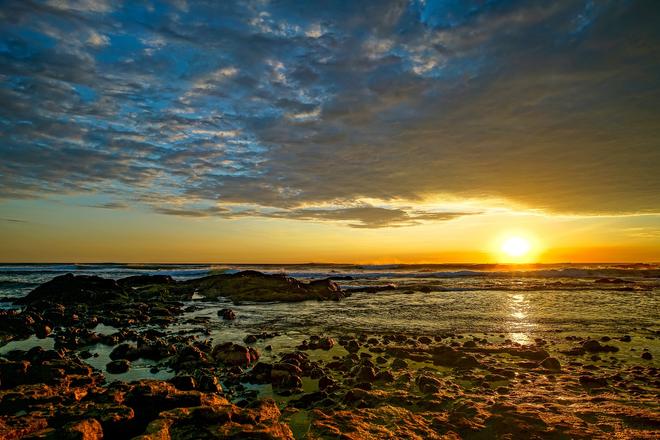
Diverse nature and "green government"
This poor region didn't cost the kings enough to send slaves, mint money or build proper colonial buildings, so the locals have been used to fending for themselves for generations. This is perhaps one reason for today's success, the different mentality and the many innovative policy moves, perhaps most famously the abolition of the army in 1948, the focus on conservation in the last few decades and the drive for a fossil-free future.
Costa Rica's renowned diversity and natural richness is perhaps best summed up by the fact that it is home to over 5 percent of all the world's natural species on just 0.03 percent of the earth's total landmass. Thanks to its amazingly variable landscape and inspiring environmental policies, we can marvel for weeks at the ingenuity of nature here, from the seas to the high mountain ranges.
One national park next to another
Costa Rica, as one big national park, and the promise of intense contact with nature is why most people come here. Over a quarter of the country's total territory is taken up by various nature reserves and protected areas, but in between there is also beautiful greenery and wildlife and birds roam wherever they please. Most restaurants and accommodation have fruit-laden feeders, so there's no shortage of colourful feathered visitors. Toucans, hummingbirds, tanagers, parrots and lots of other comical colourful chatterers will keep you company.
The best way to see birds is, of course, in the wild, for which the various wetlands and rainforest lakes are perfect. A good place to see waterfowl, for example, is the not-so-visited Caño Negro reserve in the north, where, as you cruise along the Río Frío, you'll find yourself in a realm of 315 bird species among herons, anhingas, ibis, cormorants, kingfishers, various raptors, etc. Giant iguanas lounge lazily on tree branches and caimans and crocodiles lurk inconspicuously on the muddy banks. On an evening drive, try to get close to the basilisks until they run off into the jungle with their funny slapping run. The rainforest dawns are also an unforgettable experience, as the sounds of various birds gradually begin to echo through the awakening jungle, accompanied by the almost zombie-horror-like purring of the screech owls.
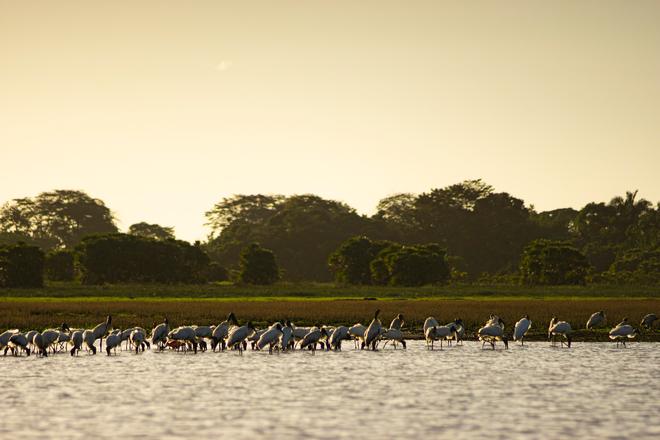
Tortuguero Caribbean Park and Heavenly River
To the north, the Caribbean coast includes the Tortuguero National Park, which is especially busy between June and October as various sea turtles, such as the right, common and leatherback sea turtles, come to lay their eggs, and then you can witness the poignant drama of the baby turtles having to cross the beach into the waves for the trip of a lifetime before they are caught by an unwary water bird. Here, too, you can venture inland along the water channels and forest paths on nature walks and spot, for example, a small vampire warbler, which is indistinguishable from the bark of the tree it hangs on even at close range.
An almost obligatory stop in the northern part of Costa Rica is a walk through the Río Celeste, or Heavenly River, forest park. You certainly won't be alone here, but in the large company of other tourists, you'll be able to marvel at the beautiful waterfall with a small lake, the confluence of two colorful rivers, a bubbling sulfate spring, and most importantly, the local magic that gave the river its name (and color). At the confluence of two fairly standard-looking streams, the colour of the water suddenly changes to a beautiful sky turquoise. This is due to the acidity of one, which flows from a volcano, and the high aluminosilicate content of the other river. By rapidly lowering the pH, these particles aggregate into nano-sized particles that cause the so-called Mie scattering of light into a beautiful turquoise colour. Devilish and heavenly at the same time! You are not allowed to swim in the reserve, but this river is worth a quick dip, for example at the bridge just below the reserve.
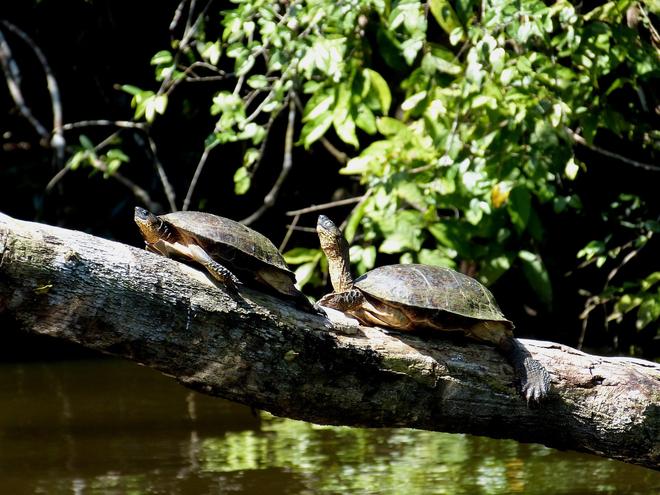
Volcanic attractions of Arenal Volcano
The whole surrounding area of northern Costa Rica is full of volcanoes, the most famous of which is probably the iconic dome of Arenal Volcano (1670 m). The crater at the top of the occasionally active volcano is unfortunately off-limits, but it's foothills are like a large amusement park and are full of all kinds of attractions for tourists, such as tree bridges, various zip-lines, rafting, cocoa and coffee excursions, day and night walks in the rainforest and, most importantly, plenty of thermal spas. In local terms, these are usually quite expensive resorts with hot-water pools, fountains and concrete decorations. The only option for bathing in a warm river right in the countryside is near the Lago Arenal dam in a rocky cascade in the forest. You can peer into the craters at other steaming volcanoes such as Poás or Irazú, but you only have a limited time to do so under strict security measures and it's just a short walk from the car park, so not much of an adventure.
The Arenal area is bordered on the south by the Monteverde misty mountain forest. These are actually various parks around the mountain town of Santa Elena, where basically everything also revolves around tourism. It is possible to go to the more remote Santa Elena mist forest reserve, but it is suspiciously quiet and not many birds are chirping. From the local lookout tower, there are fine views of the surrounding mountains and the Arenal volcano, but it likes to hide and is in the clouds most of the time. The best chances of seeing it are said to be in the mornings during October, which is still the rainy season. Another option is the more widely visited Monteverde Rainforest, where there are perhaps slightly more animals and the views from here are towards the Pacific coast.
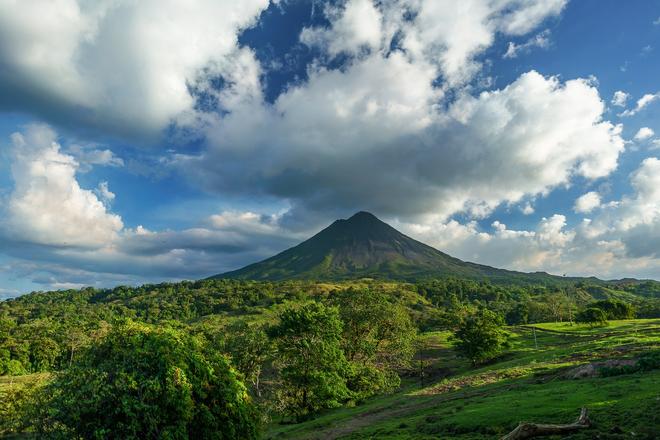
The best chance of seeing animals is in the Curi Cancha reserve. There are also themed parks focused on bats, others on butterflies, snakes or frogs, and many other adrenaline-pumping attractions that can sometimes spoil the rainforest experience with their noise. An interesting option is a night walk through the forest with a guide who can track down various interesting insects, tarantulas or even possums, porcupines or armadillos.
Crocodile River Río Grande de Tárcoles
Below the mountains, you can look down on the banks of the Río Grande de Tárcoles from the so-called Crocodile Bridge, where American crocodiles, some of which can be up to an impressive five metres long, abound. A boat trip down this river is highly recommended. Although during most of the year you probably won't be able to get to the bridge where the biggest giants live due to the shallow water, you will be delighted and pleasantly frightened by the close proximity of slightly shorter creatures.
Another great experience is a cruise to the mangroves of the coastal river Estero Guacalillo, which serves as a hatchery for small caiman for better protection. However, there are also plenty of water birds, such as the pink spoon-billed collared kingfisher, the fisher hawk and blue and tiger herons. At the mouth of the river to the sea, there are some interesting sights to see – one tree is occupied by huge pelicans and the one next to it by frigatebirds on a courtship mission, with the males strutting up the tree and puffing their huge red pouches out of their aviaries, while the females circle around and choose their seasonal mate.
Natural jewels of the coast
The nearby Manuel Antonio Reserve is known for its beautiful beaches, the chance to spot sloths, armadillos, monkeys and birds, but also for its overfed animals that suffer from obesity, diabetes and rotten teeth. It started with the animals being fed by unruly tourists and guides, then the animals learned and can now even get to the food in our backpacks on their own!
Those who want to see whales have a chance in the adjacent Marino Ballena National Park, where the coastline itself resembles the shape of a whale's fin. The whales migrate here from December to April before continuing their journey north.
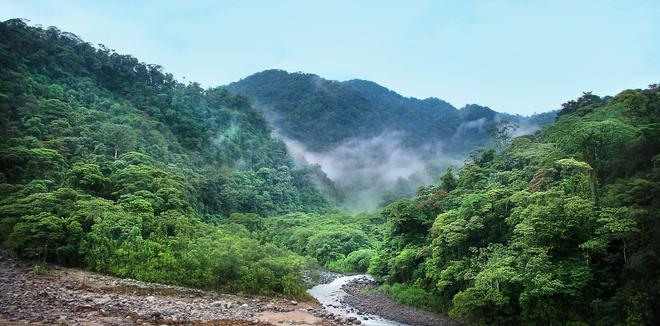
The amazing thing about Costa Rica is how you can be on a tropical beach by the sea one minute and walking up three-thousand-foot mountains a few hours later. So you can take a two-day hike up the highest mountain, Chirripó (3,820m), and see what another of the many ecosystems of this Mesoamerican garden – the so-called páramo – looks like. This is a cold, windy and wet mountain area and the completely different low vegetation corresponds to this. A little further down is Quetzales National Park, where you are almost certain to see the legendary colourful quetzal birds, whose long, colourful feathers were a highly prized part of the headdresses of Mayan and Aztec rulers and shamans.
There is also a nice walk around the Caribbean peninsula of Cahuita, where some animals have lost their last vestiges of shyness – sloths are eating leaves just off the road and monkeys and raccoons steal food straight from tourists' backpacks. It is also sad that the once thirty-metre wide white Caribbean beaches are now completely submerged by the rising sea, which is undermining the ancient trees and creeping into the rainforest.
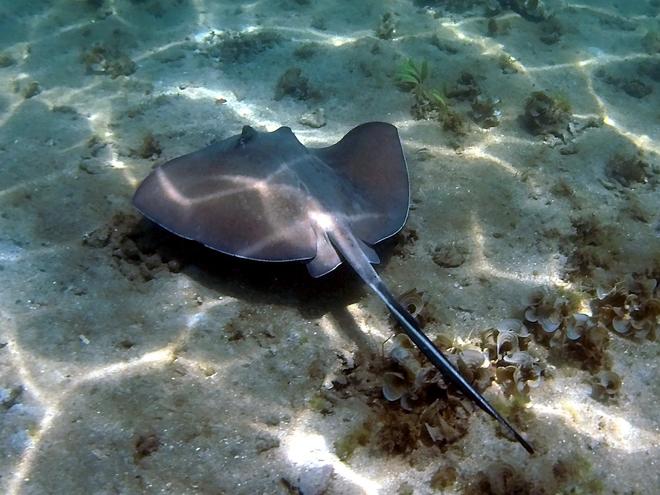
Rainforest trekking in Corcovado
Perhaps the most beautiful rainforest trekking you can experience is in Corcovado National Park on the Osa Peninsula in southern Costa Rica. A place with a turbulent history that has served as a rainforest prison and also experienced its own gold rush. Now it has been returned to nature and it is possible to admire the remnants of the primary forest around the ranger station with the Sirena hostel. There is also a stretch of forest that used to serve as an airstrip, as evidenced by the 11 wrecks of crashed small planes in its vicinity, now only accessible by sea. The best way to escape Sirena's many cohorts of tourists, however, is to take a jungle trek from San Pedrillo station towards the seaside village of Drake. Along the way, you'll have a chance to see some of Costa Rica's six species of toucans, rhinos, anteaters, wrens, hooded mergansers, and plenty of exotic insects and reptiles on night walks. Swimming in the rainforest river and under the wild waterfall is a refreshing experience.
It is compulsory to have a guide here, which you will appreciate if, for example, you discover hidden on the road ahead of you the local most widespread venomous snake, the velvet bush snake, whose bite gives a healthy person a maximum of 5 days to travel 100 km to the nearest hospital for anti venom serum.
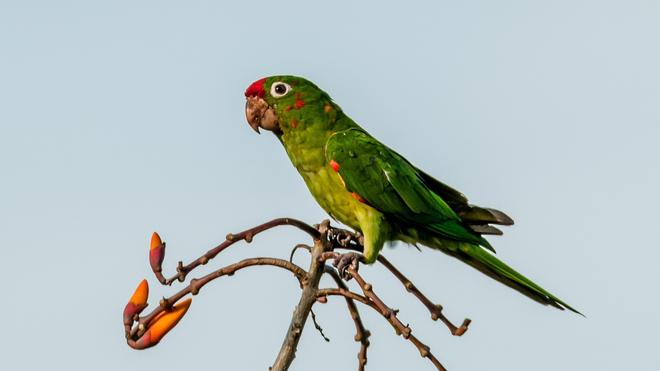
It used to be possible to walk for days through the rainforest along the coast and wade in the estuary with crocodiles and sharks at low tide, but nowadays no permits are issued. The sea here washes up bales of drugs, which smugglers dump from their boats into the sea when they are discovered by the guards, and locals then search for them on the shore. No one involved has time to wonder who is who.
Not a cultural highlight
Culture and history lovers will probably not find a lot to discover in Costa Rica. Due to the Spanish Crown's disinterest in the area and high seismic activity, not much has survived from colonial times apart from a few churches. The colonisers managed to almost wipe out the original cultures, leaving us with only a few details, such as the mysterious stone balls left by the Diquís tribe. The historically and economically most important cities of San José and Limón also offer little and are renowned hotbeds of crime. Fans of brutalism may appreciate some of the modern reinforced concrete churches of Costa Rica's towns and villages.

For gourmet food, you will enjoy the always fresh casado, which consists of black beans, salad, rice, plátano, nachos and some meat. The amazing crumbling stew carne en salsa is an excellent alternative. Compared to Nicaraguan or Mexican ingenuity, however, Costa Rican cuisine can seem a bit repetitive after a while. Wealthy Americans are more likely to venture into classic restaurants, but local eateries, called sodas, have excellent food for a few dollars.
For travelers, it can be nice to see how the infrastructure works here, the people are very nice, and you can tell that they have long been ranked in statistics as one of the happiest people in the world. The preparedness for tourists could be considered a bit over the top, there are adrenaline attractions everywhere, must-see gardens with a waterfall and so on. However, this makes it a relatively clean and mostly ecologically minded country that certainly deserves the income from tourism. Pura vida (the most common Costa Rican greeting and saying)!
